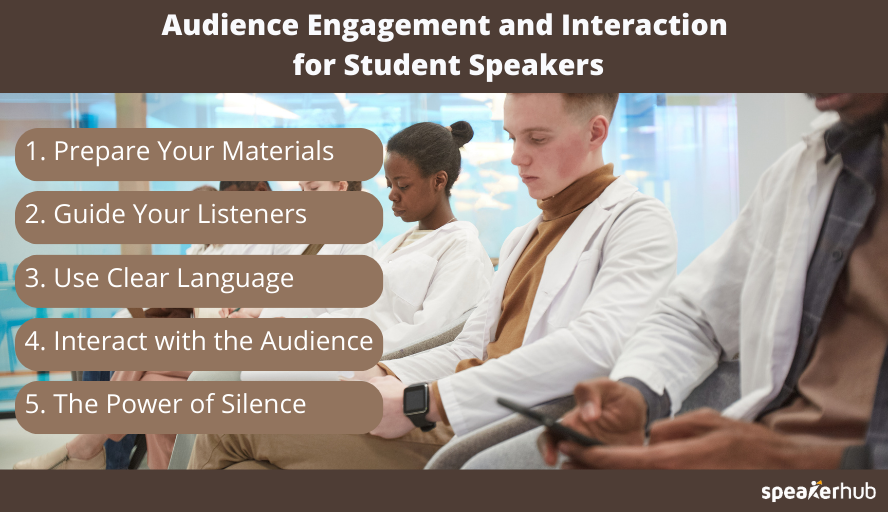6 Audience Engagement and Interaction Tips for Student Speakers

Oration has been perfected and developed over thousands of years, from ancient Greece and the Senate of the Roman Empire to modern conferences and presentations.
It takes natural charisma and talent to orate and control an audience, but anyone can master basic public speaking skills and perform well. After all, in the end, the final impression you leave the audience determines the success of your speech, not just the presentation’s content.
If you are in business, you’re tasked to sell goods to investors. Moreover, if you are a professor at a lecture, your mission is to convey new information to students. The same goes for student speakers tasked to explain a topic in class.
Regardless of the situation, your ability to work with the audience determines the success of your presentation. We have prepared some valuable tips and techniques to help you improve your skills and succeed.

1. Prepare Your Materials
First of all, you need to prepare for the presentation. Your lecture can often only last a few minutes, but it can take days or weeks to organize. Rehearsals are also the key to the success of any presentation, even if you just need to speak in front of your class and college professor.
When requested to speak in front of a group or to deliver a presentation, you should first find out why. What are its desired results from the perspective of the organizers and the audience? The answers will let you understand its purpose and how to best interact with your audience.
When planning a significant event or conference, it's also helpful for organizers to have all the PowerPoint presentations ready a few days in advance. This allows them to load all the presentations and brand them appropriately before the event. Some conferences also need speaker bios ahead of the event for use in promotional materials. Ensure that you find out what materials are required and when before the presentation.
In addition, if you need extra time to compose an essay or a speech, you can always pay someone to write your essay and ask the experts to do it for you. It will not go down well if you show up on the day of the presentation and reveal that you rewrote the whole thing while riding the subway.
If a third party or the venue provides the audiovisual equipment for your presentation, the event's organizers should also prepare the adjustments you need.
2. Guide Your Listeners
It is imperative to be on the same wavelength as the listeners and to keep their attention. The first thing that will instantly ruin the impression of your presentation is if you start reading your notes. Remember, nothing looks more unconvincing and pathetic than someone who reads notes instead of speaking in front of an audience.
Try to saturate your speech with lively intonations. Listeners pick up shifts in tone, pitch, volume, and even physical posture. Capture your audience's attention, and don't let it go!
To keep your audience interested, don't forget to use foreshadowing. Periodically inform your listeners about what you’re discussing next. Previews foretell the message or how you will expand on a previous subject. For example, you can say, "First, I will explain how the EPA arrives at its numbers."
An excellent summary will also highlight the crucial points of the material that you just discussed. An outline may help reframe and refocus the conversation after elaborating on a topic at length or following a series of supporting information.
And don't forget about transitions! Transitions ensure that no one gets left behind when moving from one topic to another. They demonstrate the interconnectedness of your information and the significance of your argument, enhancing the flow of your writing. Transitions should be more overt when giving an oral presentation than in written work. They inform your audience that you are progressing and also in what direction.
3. Use Clear Language
The clarity of your language is as vital as the intonation and content of the text. You need all three factors to catch your audience's attention.
When you test your speech, try reading it out loud a few times, and be sure to practice in front of a test audience. Rehearsals will help you eliminate verbal garbage and heavy phrases and find the best wording to convey the message.
Don't use pronouns that aren't clear. These seem awful on paper but sound worse when spoken. It would help to avoid phrases like "the former...the latter" and "respectively". Both formulations function like pronouns, requiring the reader to retain information for subsequent use. The issue is that the audience may not have been paying attention since they may not have known they would be "tested" on the information they had heard before.
4. Interact with the Audience
Audience interaction is one of the most critical elements of any presentation. It’s a simple and effective technique that will help you keep your listeners' attention in focus. There are many ways to interact with the audience, from simple questions to more advanced tests and quizzes that you can prepare.
In case your presentation generates follow-up inquiries, you should also have a few backup slides ready. By explaining it quickly, you may increase the likelihood of being asked a question regarding an important part of your speech. Ask for the question to be restated if you need clarification.
Getting no questions implies nothing about the quality of your presentation. Folks may be weary and ready to go home at the end of the day, regardless of how effectively you have explained your content.
5. The Power of Silence
It pays to stop talking sometimes. The power of a well-placed pause cannot be overstated. It gives your audience time to process what you've said and to respond if they want to. It's crucial to do so while delivering comedic material so that the next section of your presentation doesn't get lost in the roar of the audience’s laughter.
Never be afraid to use pauses. If you constantly chatter and do not allow a single moment of silence, this will likely betray you as a weak, insecure, and inexperienced speaker.
6. Structure Your Speech
Unless you're born a genius speaker, we recommend sticking to the classic tips for structuring your presentation. Lay down the main ideas in the introduction and announce your thesis. Reveal all the stated statements in the central part and never forget about a decisive conclusion.
It’s best to reiterate your main points, especially now that you have shared supporting facts in your speech. You can also add links to credible sources to support your ideas.
The Bottom Line
Never underestimate the power of speech. Presenting yourself and conveying a message through speech can be valuable regardless of the situation or purpose. Whether you’re trying to compel a promising investor or simply presenting your project in the classroom, it’s best to make an effort and consider composing a strong presentation. This helps you overcome your stage fright, believe in yourself, and acquire the critical skills you need in your future career.






